LiveU Puts the Power of a News Van in Your Backpack (Video)

Share

I saw this news team using LiveU at the launch of the iPad. Cheaper and more mobile than traditional news uplinks, it could change the face of media.
I was covering Apple's recent premiere of the iPad when I saw some guy with a professional video camera plugged into his backpack. Was he some Apple mega-fan with a screw loose? Nope, turns out he was broadcasting a live news feed onto the internet. The backpack was part of an uplink system developed by LiveU. Instead of an entire news van, there's just a box in a bag. It's an amazing bit of technology that uses 3G, 4G, and WiFi to provide upload streams between 1 and 2 Mbps. That's broadcast TV quality without any wires. Just plug any video camera into the backpack and you're practically ready to go. The system sets up in one minute, goes anywhere anytime, and can stay on the move. LiveU was used to provide coverage on the train President Obama rode into Washington DC. It allowed internet news casters to provide around the clock coverage leading into the Grammys. According to LiveU's Twitter feed, these backpacks are going to be all over the Super Bowl. The LiveU revolution is already happening, and its going to democratize the ability to provide high quality live video to the world. Check out their demo below. The picture is gorgeous!
Satellite uplinks and microwave broadcasts are an expensive part of running your own news organization. They also have trouble transmitting on the go. LiveU costs just a fraction of traditional news feeds (more on that below) and it can work anywhere you get a mobile phone signal. That's a freedom of economy and mobility that has helped LiveU grow at an amazing rate since it began last year. As this trend continues LiveU, or its eventual competitors, will change the face of live video. Now Internet channels and traditional broadcast TV networks may end up using the same equipment. More companies will be able to get into the live broadcast business and that could provide an explosion in the news offered. It might even lead to a better informed populous.
LiveU's LU-30 transmitter (the box in the bag) uses six mobile phone cards to upload its video stream. In the US, that means two cards apiece for Sprint, AT&T, and Verizon. The LU-30 constantly measures the speed of each connection and dynamically varies their datastreams to maintain a constant speed of either 1 or 2 Mbps. In the presence of WiFi, the LU-30 will automatically shunt over an appropriate amount of bandwidth (0-100%), and there's even an Ethernet option for those times when going wired is preferable.
When I first got interested in LiveU, I thought that this might be something that Singularity Hub could casually pick up for fun. It's not. While the LU-30 is cheaper than a news van, it's still expensive enough to merit a major investment for an internet news channel. According to the New Jersey office, a 1 Mbps uplink (internet video quality) will cost around $1500 a month with a mandatory one year contract ($18k total). 2 Mbps (broadcast TV quality) costs around $2500 a month ($30k/year). For those prices you get a LU-30 transmitter and 30 hours of connectivity per month. Additional use costs $3/min though there are package deals if you buy ahead of time (a total of 50 hours at 2 Mbps is around $3k per month). A receiver (basically a PC server) can be purchased for a one time price of around $1000. All of these costs are a pittance compared to the money you'd spend on a traditional system, but they aren't trivial.
Be Part of the Future
Sign up to receive top stories about groundbreaking technologies and visionary thinkers from SingularityHub.


The big question I have is how well these systems work. I've seen plenty of great news feeds the LU-30 has provided for major corporations (as in the above video). However, at the Apple launch, the operator was having difficulty with getting his uplink to work. To be fair, I didn't jump in and ask him how much training he had, and he could have been techno-deficient. LiveU stresses, on their website and on the phone, that their equipment is remarkably easy to use and can be set up in about a minute. They offer training when you purchase the system, and they're always there for live support. Indeed, the guy at the Apple launch sounded like he was on the phone with a technician at the time.
Judging by their increasing use at major news events, however, I think the LU-30 must be doing something very right. Mobile phone and WiFi coverage is blanketing the globe and with that comes a great opportunity for a new form of live news broadcast. I think we're likely to see a big growth in the number of mobile live news feeds on the Internet both related to or independent from traditional news corporations. Eventually, as mobile phone video quality improves, live broadcasts will constitute an even smaller investment. One day, we'll all be able to transmit our live video online with the same quality as the local TV channel. The idea of the mainstream media may fade when everyone becomes their own source of media.
Photo credit: Aaron Saenz
Related Articles

This Light-Powered AI Chip Is 100x Faster Than a Top Nvidia GPU

How Scientists Are Growing Computers From Human Brain Cells—and Why They Want to Keep Doing It

These Brain Implants Are Smaller Than Cells and Can Be Injected Into Veins
What we’re reading